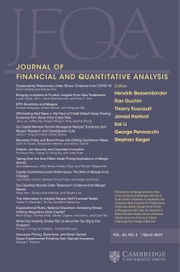No CrossRef data available.
Article contents
Option Factor Momentum
Published online by Cambridge University Press: 10 April 2025
Abstract
We document significant time-series and cross-sectional momentum in 28 equity option factors. Factor momentum is distinct from a static factor portfolio, and prominent option factor models cannot fully explain its returns. Despite high autocorrelation, factor momentum profits are mainly driven by high and persistently different mean factor returns in the case of longer formation periods. Option factor momentum fully subsumes option momentum, but not vice versa. Our findings are robust over time, across various market states, and for alternative momentum strategy constructions.
Information
- Type
- Research Article
- Information
- Creative Commons
- This is an Open Access article, distributed under the terms of the Creative Commons Attribution licence (http://creativecommons.org/licenses/by/4.0), which permits unrestricted re-use, distribution and reproduction, provided the original article is properly cited.
- Copyright
- © The Author(s), 2025. Published by Cambridge University Press on behalf of the Michael G. Foster School of Business, University of Washington
Footnotes
We are grateful to an anonymous referee, Manuel Ammann, Hendrik Bessembinder (the editor), Philipp Decke (discussant), Pasquale Della Corte, Bowen Du (discussant), Can Gao, Jens Jackwerth, Julian Kölbel, Manuel Leininger (discussant), Martin Nerlinger, Lasse Pedersen, Killian Plusanski (discussant), Ryan Riordan, Florian Weigert, Bo Yuan (discussant), and seminar participants at the University of Konstanz, the University of Liechtenstein, the University of St. Gallen, the 2023 Elsevier Finance Conference at FGV EBAPE in Rio de Janeiro, the 2023 Australasian Finance and Banking Conference, the 2024 International Conference of the French Finance Association, the 2024 Frontiers of Factor Investing Conference, the 2024 Structured Retail Products and Derivatives Conference, the 2024 FMA Europe Conference, and the 2024 FMA Asia/Pacific Conference for their constructive and insightful comments.

